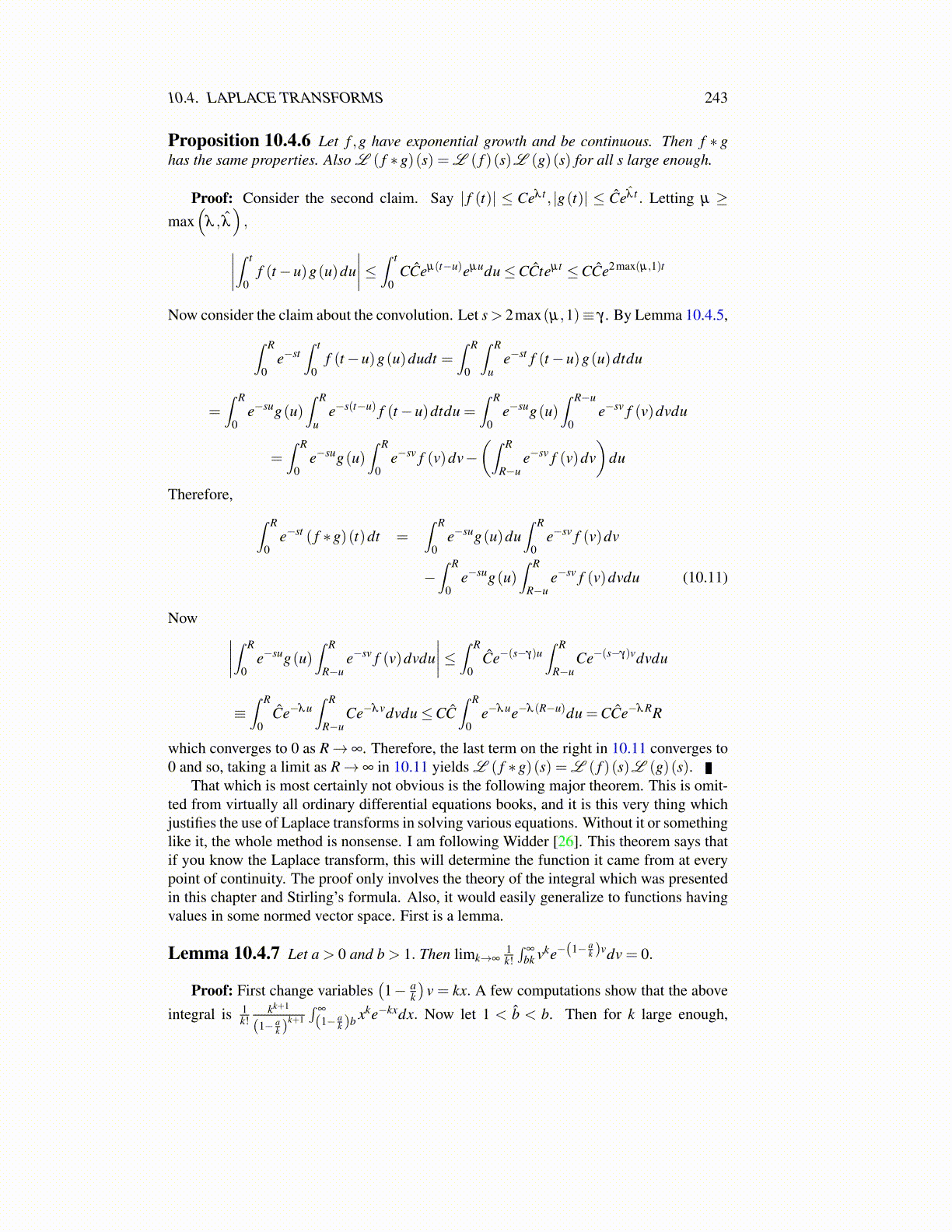
10.4. LAPLACE TRANSFORMS 243
It remains to consider the other two integrals.
1k!
∫ t−δt k
0vke−v
(φ
( tvk
)−φ (t)
)dv+
1k!
∫∞
t+δt k
vke−v(
φ
( tvk
)−φ (t)
)dv (∗)
Now v→ vke−v is increasing for v < k. The first of these, on this interval, tvk ≤ t− δ and
so there is a constant C (t) such that∣∣φ ( tv
k
)−φ (t)
∣∣<C (t). Thus, using Stirling’s formula,the first integral is dominated by
C (t)1k!
∫ t−δt k
0vke−vdv ≤ 2C (t)
1√2πkk+1/2e−k
(t−δ
tk)(
t−δ
tk)k
e−(t−δ
t k)
< 2C (t)1√2π
√k(
eδt
(1− δ
t
))k
≡ 2C (t)1√2π
√krk
where r ≡ eδt
(1− δ
t
)which is less than 1 since δ < t. Then limk→∞
√krk = 0 by a use of
the root test. In the second integral of ∗,∣∣φ ( tv
k
)−φ (t)
∣∣≤C (t)em tvk . Then, simplifying this
second integral, it is dominated by C(t)k!∫
∞t+δ
t k vke−(1−mtk )vdv which converges to 0 as k→∞
by Lemma 10.4.7.I think the approach given above is especially interesting because it gives an explicit
description of φ (t) at most points1. I will next give a proof based on the Weierstrass approx-imation theorem to prove this major result which shows that the function is determined byits Laplace transform. I think it is easier to follow but lacks the explicit description givenabove. Later in the book is a way to actually compute the function with given Laplacetransform using a contour integral and the method of residues from complex analysis.
Lemma 10.4.9 Suppose q is a continuous function defined on [0,1] . Also suppose thatfor all n = 0,1,2, · · · ,
∫ 10 q(x)xndx = 0. Then it follows that q = 0.
Proof: By assumption, for p(x) any polynomial,∫ 1
0 q(x) p(x)dx = 0. Now let {pn (x)}be a sequence of polynomials which converge uniformly to q(x) by Theorem 6.10.2. Saymaxx∈[0,1] |q(x)− pn (x)|< 1
n Then
∫ 1
0q2 (x)dx =
∫ 1
0q(x)(q(x)− pn (x))dx+
=0︷ ︸︸ ︷∫ 1
0q(x) pn (x)dx
≤∫ 1
0|q(x)(q(x)− pn (x))|dx≤
∫ 1
0|q(x)|dx
1n
Since n is arbitrary, it follows that∫ 1
0 q2 (x)dx = 0 and by continuity, it must be the casethat q(x) = 0 for all x since otherwise, there would be a small interval on which q2 (x) ispositive and so the integral could not have been 0 after all.
Lemma 10.4.10 Suppose |φ (t)| ≤Ce−δ t for some δ > 0 and all t > 0 and also that φ
is continuous. Suppose that∫
∞
0 e−stφ (t)dt = 0 for all s > 0. Then φ = 0.
1If φ is piecewise continuous on every finite interval, this is obvious. However, the method will end up showingthis is true more generally.